A sprained ankle is an injury that happens once you roll, twist, or awkwardly turn your ankle joint. This will stretch or tear the tough bands of tissue (ligaments) that help hold your ankle bones together. Ligaments help stabilize joints, preventing excessive movement. A sprained ankle happens once it forces the ligaments beyond their normal range of motion. Most sprained ankle joints involve injuries to the ligaments on the outer aspect of the ankle. A sprain is distinct from a strain. Sprains injure ligaments, whereas strains affect muscles or tendons. The symptoms of the two injuries are very similar. For this reason, identifying a sprain from a strain without the help of a doctor is tough. The type of ankle sprain you’ve undergone will determine your treatment preferences and recovery time.
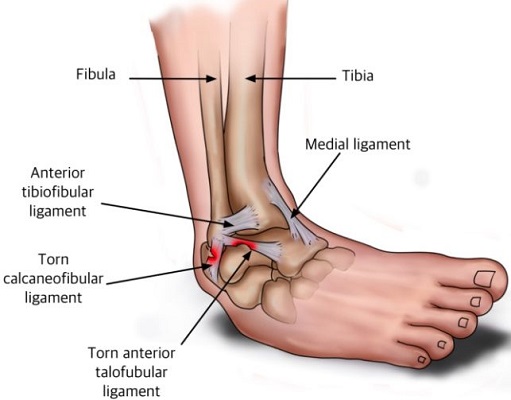
An ankle joint sprain will cause intense pain within the joint and make it tough to move the ankle joint or walk. Treatment for a sprained ankle joint depends on the severity of the injury. Though self-care measures and over-the-counter pain medications could also be needed, a medical evaluation is necessary to reveal how badly you’ve got a sprained ankle and to determine the suitable treatment for speed up your ankle sprain recovery time.
Ankle Joint Anatomy
Bones of the Ankle Joint
The ankle joint is formed by three bones-
- Tibia – the main bone of the lower leg. It bears most of the body’s weight. Its lower end portion forms the medial malleolus of the ankle.
- Fibula – the smaller of the two bones within the lower leg. Its lower end forms the lateral malleolus of the ankle joint.
- Talus – the top bone of the foot.
Tendon of the Ankle Joint
Tendons connect muscles to bones.
- Many muscles control motion at the ankle joint. Each encompasses a tendon connecting it to one or more of the bones of the foot. Tendons are often torn once the joint is subjected to bigger than normal stress.
- Tendons can also pull off the bone, known as an avulsion injury.
Major Muscles of the Ankle
- The calf muscles (gastrocnemius and soleus), which connected to the calcaneus via the Achilles tendon. The tightening and relaxing of the calf muscles permit the ankle to bend downward and upward.
- The peroneal muscles (peroneus longus and peroneus brevis), on the outside edge of the ankle and foot. These muscles provide the ankle to bend downward and outward.
- The anterior tibialis muscle, which permits the ankle and foot to turn upward.
- The posterior tibialis muscle, which supports the arch of the foot and facilitates the foot to turn inward.
The complexity of the ankle’s muscular and ligament structure creates many possible events for injuries when the ankle is pushed beyond its normal range of motion.
Ligaments of the Ankle Joint
Ligaments give the connection between bones. Sprains are injuries to the ligaments. The lateral ligaments lie on the outside of the ankle, which is the most frequently injured in an ankle sprain. These include the following:
- Anterior-Talofibular Ligament (ATFL)
- Calcaneo-Fibular Ligament (CFL)
- Posterior-Talofibular Ligament (PTFL)
The main medial (inside of the ankle) ligament is the much stronger ligament (Deltoid).
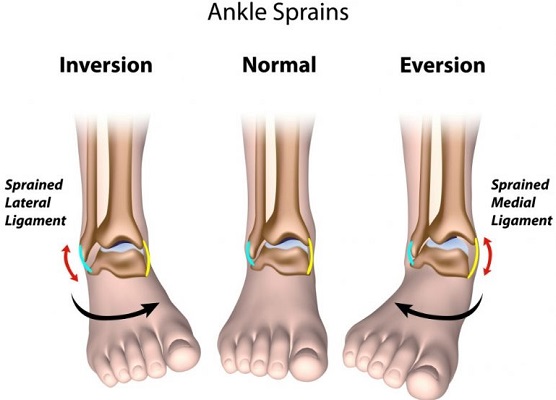
High ankle sprains affect inferior tibiofibular ligament and syndesmosis. These are more debilitating ankle sprains and are often misdiagnosed as the simpler sprained ankle.
Ankle Sprain Causes
Ankle sprains usually occur by excessive external rotation, inversion, or eversion of the foot caused by an external force. When the foot is moved beyond its range of motion, extreme stress puts a strain on the ligaments. If the strain is powerful enough to the ligaments past the yield point, then the ligament comes damaged or sprained. Causes of a sprained ankle may include:
- A fall that provokes your ankle to twist
- Landing awkwardly on the foot when jumping or pivoting
- Walking or physical exercise on an uneven surface
- Stepping or landing another person on your foot during a sports activity
Sprained ankles are the foremost frequent form of musculoskeletal injury seen by primary-care providers. Ankle sprains are very common in sports injuries; However, conjointly happens throughout everyday activities. An unnatural twisting motion of the ankle will happen once the foot is planted awkwardly, once the ground is uneven, or once an unusual amount of force applies to the joint.
Ankle Sprain Risk Factors
The risk of a sprain involves explosive side-to-side motion, such as skateboarding, tennis, or basketball. Sprained ankles can likewise occur during normal daily activities, such as stepping off a curb or slipping on ice. Factors that enhance your risk of a sprained ankle comprise:
- Ankle sprains are frequent in sports injuries, typically in sports requiring jumping, cutting action, or rolling or twisting of the foot like basketball, football, tennis, soccer, and trail running.
- Walking or running on uneven surfaces or poor field conditions might increase the chance of an ankle sprain.
- Once you’ve got sprained your ankle or had another form of an ankle injury, you are more probably to sprain it once more.
- Poor strength or flexibility in the ankles might increase the chance of a sprain once participating in sports.
- Shoes that do not fit properly or are not appropriate for the activity and high-heeled shoes build ankles more liable to injury.
Ankle Sprain Symptoms
Sprained ankle signs and symptoms depending on the severity of the injury. A sprained ankle joint is painful. Others could comprise:
- Pain, particularly after you bear weight on the affected foot
- Swelling
- Bruising
- Tenderness after you touch the ankle joint
- Restricted range of motion
- Instability within the ankle joint could occur once there has been complete tearing of the ligament or complete dislocation of the ankle joint.
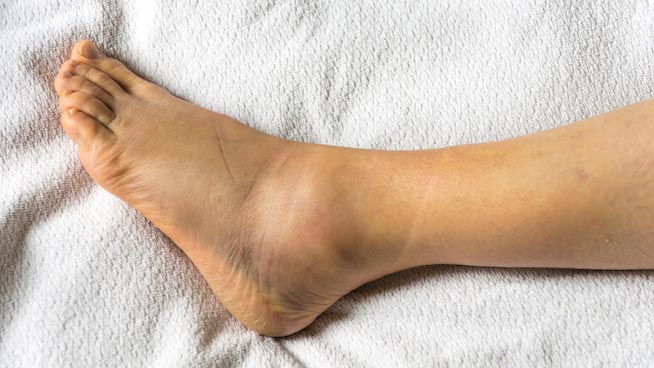
Popping sensation or sound at the time of injury – If there’s severe tearing of the ligaments, you may additionally hear or feel a “pop” once the sprain happens. Symptoms of a severe sprain are the same as those of a broken bone and need prompt medical evaluation.
Recommended Post
- Top Rated ASO Ankle Brace for Ankle Support
- Top-Rated Aircast Airsport Ankle Brace Reviews
- Best Shoes For Plantar Fasciitis As Per User Reviews
- Most Comfortable Steel Toe Boots For Standing All Day
Ankle Sprains Types
Inversion ankle sprain/ Lateral ankle sprain
The most common form of ankle sprain happens once the foot is inverted too much, affecting the lateral aspect of the foot. Once this ankle sprain happens, it stretches the outer or lateral ligaments too much. The anterior talofibular ligament is one of the foremost commonly involved ligaments during this sprain. More or less 70–85% of ankle sprains are inversion injuries.
When the ankle joint becomes inverted, the anterior talofibular and calcaneofibular ligaments are damaged. This is often the most common ankle sprain.
Eversion ankle sprain/ Medial ankle sprain
A less common variety of ankle sprains an eversion injury, affecting the medial aspect of the foot. This happens once the foot, instead of the ankle joint rotating medially resulting in an inversion (the foot being rolling to the inside), the ankle joint rotates laterally, resulting in an eversion (when the foot rolls to the outside). Once this happens, the medial (deltoid) ligament stretches too much.
High (Syndesmotic) Ankle Sprain
A high ankle sprain is an injury to the large ligaments on top of the ankle that join along with the lower leg’s two long bones, referred to as the tibia and fibula. High ankle joint sprains usually occur from a sudden and forceful outward twisting of the foot that usually happens in contact and cutting sports like rugby, ice hockey, football, roller derby, volleyball, lacrosse, basketball, softball, baseball, ultimate frisbee, track, soccer, tennis and badminton, and horse riding.
Ankle Sprain Diagnosis
Physical Examination
When diagnosing a sprain or strain and grading its severity, your doctor can diagnose your ankle sprain by a careful examination of your foot and ankle. This physical examination could also be painful.
- Examine the affected ankle visually to distinguish the extent of swelling and bruising.
- Palpate the injury site gently presses around the ankle joint to determine which ligaments are hurt.
- Your doctor can move your ankle joint in many directions (Rotate, flex, or extend the foot and ankle to check a range of motion); However, a stiff, swollen ankle typically won’t move much.
If there’s no broken bone, your doctor could tell the severity of your ankle sprain primarily based upon the amount of swelling, pain, and bruising.
Imaging Tests
Order diagnostic investigation, like X-ray or Magnetic Resonance Imaging (MRI) to determine exactly which tissues are harmed and where, and to find out a possible bone fracture, bone chips, or other coincident joint-surface injuries. Sometimes, MRI may have to be delayed until the initial swelling and bruising subside.
- X-rays provide pictures of dense structures, like bone. Your doctor might order x-rays to rule out a broken bone in your ankle or foot. A broken bone will cause similar symptoms of pain and swelling of the ankle sprain. Besides plain x-rays, your doctor may order stress x-rays. They take these scans while the ankle is being pushed in many directions. Stress x-rays help to point out whether the ankle is moving abnormally because of injured ligaments.
- Your doctor could order an MRI if he or she suspects a severe injury to the ligaments, damage to the joint surface’s cartilage or bone, a small bone chip, or another problem. They’ll not order the MRI until after the period of ankle sprain swelling and bruising resolves.
- May order an ultrasound imaging scan that directly observes the ligament, whereas he or she moves your ankle. This helps your doctor to work out how much stability the ligament provides.
Ankle Sprain Grades
There are three degrees of ankle sprains. The type of ankle sprain will determine your treatment preferences and recovery time.
- Grade I Mild – First-degree ankle sprains are the mildest. In most cases, the ligament has been stretched but has not torn. You may experience minor pain, some stiffness, a little swelling, and tenderness with little impact on function.
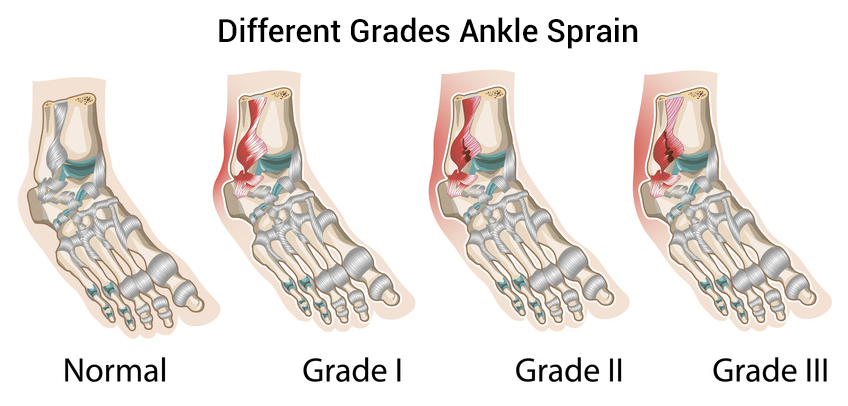
- Grade II Moderate – Second-degree ankle sprains typically involve a partial tear of the ligament. This is the most common type of ankle sprain and is characterized by moderate pain in addition to swelling, bruising, and some difficulty with movement. Reduced proprioception, ROM, and instability
- Grade III Severe – Third-degree sprains occur when the ligament has torn completely. This is the most severe type of sprain, and typically involves immense pain, loss of motion, swelling, and joint instability. You should see a doctor soon to determine the correct form of treatment.
Ankle Sprain Treatment
Almost all ankle sprains will be treated without surgery. Even a complete ligament tear will heal without surgical repair if it’s immobilized appropriately. A three-phase program treatment method for all ankle sprains—from mild to severe:
- Phase one comprises resting, protecting the ankle joint, and reducing the swelling.
- Phase two includes restoring the range of motion, strength, and flexibility.
- And Phase three consists of maintenance exercises and therefore the gradual return to activities that don’t need turning or twisting the ankle.
This can be followed later by having the ability to do activities that require sharp, unexpected turns (cutting activities) like tennis, basketball, or soccer. This three-phase treatment program could take just 2 weeks to complete for minor sprains or up to six to twelve weeks for more severe injuries.
Ankle Sprain Treatment at Home
For milder sprains, your doctor could suggest simple home treatment. Follow the RICE Protocol as shortly as doable after your injury:
- Rest your ankle and not walking on it.
- Immediately applies ice to keep the swelling down. You’ll be able to use it for 20 to 30 minutes, three or four times daily. Don’t apply ice directly to your skin.
- Ankle sprain compression socks, bandages, or ace-wraps can immobilize and support your injured ankle joint.
- Elevate your ankle above the level of your heart as usually as doable throughout the first 48 hours for reducing swelling for the ankle sprain. It will assist your venous drainage.
Ankle Sprain Pain Relief
Nonsteroidal anti-inflammatory drugs (NSAIDs) medication like ibuprofen and Naprosyn will facilitate control of pain and swelling. As a result of they improve function by both reducing swelling and controlling pain; They’re a better choice for mild sprains than narcotic pain medicines.
Nonsurgical Treatment of ankle Sprain
Some sprains will require treatment besides the RICE protocol and medications.
Crutches – In most cases, swelling and pain can last from two to three days. Walking is also tough during this time, and your doctor might suggest that you use crutches as required. You can use iWALK2.0–Hands-Free Crutch that offers greater mobility and eliminates pain linked with traditional crutches.
Immobilization – throughout the early phase of ankle sprain healing, it’s necessary to support your ankle and shield it from unexpected movements. For a Grade two sprain, a removable plastic device like a cast-boot, walking boots for sprained ankles, Aircast Air-Stirrup ankle brace or lace-up braces for 7-10 days followed by early, functional rehabilitation will offer support. Grade three ankle sprains might need a short leg cast or semi-rigid ankle brace for 2 to 3 weeks.
Your doctor might encourage you to put some weight on your ankle, whereas it’s protected. This may facilitate ankle sprain healing time.
Ankle Sprain Physical Therapy for Speed-Up Recovery Time
Rehabilitation exercises prevent stiffness, increase ankle strength, and stop chronic ankle issues. Following exercises for ankle sprain start under the supervision of a physical therapist-
Early Motion – to forestall stiffness, your doctor or the physical therapist can offer you exercises that involve range-of-motion or controlled movements of your ankle while not resistant.
Strengthening Exercises – Once you’ll bear weight without exaggerated pain or swelling, then exercises to encourage and strengthen the muscles and tendons within the front and back of your leg and foot are value-added to your treatment plan. Water exercises are also used if land-based strengthening exercises, like toe-raising, and are too painful. Then they add exercises with resistance as tolerated.
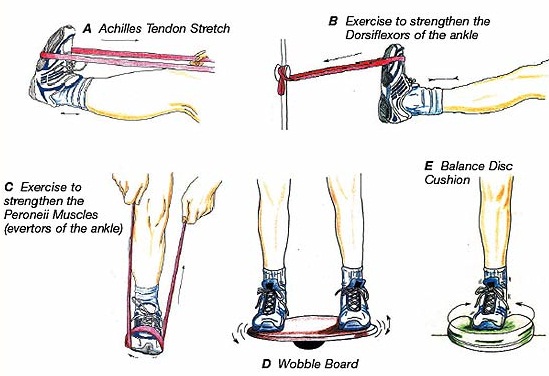
Proprioception (Balance) Training – Poor balance typically results in repeat sprains and ankle instability. A decent example of a balance exercise is standing on the affected foot with the alternative foot raised and eyes closed. Balance boards are typically employed in this stage of rehabilitation.
Endurance and Agility Exercises – Once you’re painless, different exercises are also value-added, like agility drills. Running in more and smaller figures-of-8 is excellent for agility and calf and ankle joint strength. The goal is to extend strength and range of motion as balance improves over time. Once you’re painless, resistance exercises are also value-added to your therapy program.
Ankle Sprain Surgical Treatment
Surgical treatment for ankle sprains is rare. Surgery is reserved for injuries that don’t respond to nonsurgical treatment, and patients who experience persistent ankle instability after months of rehabilitation and nonsurgical treatment. Surgical options could include:
In arthroscopy surgery, your doctor uses a small camera, known as an arthroscope, to look within your ankle joint. Miniature instruments are accustomed to removing any loose fragments of bone or cartilage, or they will catch components of the ligament within the joint.
- Reconstruction – Your doctor could repair the torn ligament with stitches or sutures. Sometimes, they will reconstruct the broken ligament by replacing it with a tissue graft obtained from other ligaments and/or tendons found within the foot and around the ankle.
- Immobilization – There’s generally a period of immobilization following surgery for an ankle joint sprain. Your doctor could apply a cast or protecting boot to safeguard the repaired or reconstructed ligament. Be sure to follow your surgeon’s directions regarding however long to wear the protecting device; If you remove it too soon, a simple misstep will re-tear the fixed ligament.
- Rehabilitation- After surgery involves time and attention to restore strength and range of motion; thus, you’ll come back to pre-injury function. The length of time you’ll expect to spend recovering depends upon the extent of the injury and also the amount of surgery that was done. Rehabilitation might take from weeks to months.
Ankle Sprain Recovery Time
There is no specific time-frame of the ankle sprain recovery. Whereas the ligaments themselves can take a minimum of six weeks to heal, your muscle strength, the range of motion, proprioception, and come back to function will differ. Here are some general guidelines.
Grade 1 – Mild Ankle Sprain Recovery Time
In gentle cases, you’ll be able to expect ankle sprain healing time within two to three weeks; However, it’ll take at least six weeks for full scar tissue maturation.
Despite most of the people being told to simply “rest” and it’ll recover, these mild sprains typically lead to joint stiffness, ligament laxity, muscle weakness, or tightness and reduced proprioception.
If not appropriately treated, these often cause your ankle and foot joints many injuries months or years down the track.
Grade 2 – Moderate Ankle Sprain Recovery Time
Grade two injuries occur once a major ligament injury allows the ligament to a fault stretch. In most cases, these injuries lead to a recovery period of four to six weeks. With increasing injury severity, the rehabilitation method becomes more complicated and extensive.
All Grade 2 ankle sprain ought to rehabilitate to enable the full range of motion and strength, full proprioception, power, and agility with full come back to sport-specific drills.
Grade 3 – Severe Ankle Sprain Recovery Time
Grade three ligament injuries are once the ligament is fully damaged. The more severe ankle joint sprain injuries may include fractures of the bones or high ankle joint sprains, which can need extra rehabilitation time to a simple lower ankle sprain.
The rehabilitation of Grade three ankle sprains normally takes six to twelve weeks, however, is variable depending on your specific injury. Your physical therapist or doctor can provide you with more specific tips and recommendations.
Outcomes for ankle sprains are good. With appropriate treatment, most patients can return to their day-to-day activities after a while.
Most importantly, successful outcomes depend on a patient’s commitment to rehabilitation exercises. Incomplete rehabilitation is the most familiar cause of chronic ankle vulnerability after a sprain. If a sufferer stops doing the strengthening exercises, the injured ligament will weaken and put the sufferer at risk for continued ankle sprains.
Ankle Sprain Prevention
The finest way to avoid ankle sprains is to keep good muscle strength, balance, and flexibility. The following cautions will further inhibit sprains:
- Warm-up perfectly before exercise and physical activity.
- Pay careful mind when running, walking, or working on an irregular surface.
- Wear appropriate shoes that exactly fit your activity.
- Quiet or slow down activities when you get tenderness or fatigue.
